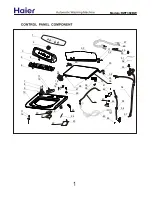
placed in
4.
5.Loading the Dishwasher Baskets
5.Loading the Dishwasher Baskets
For washing in the dishwasher the following cutlery/dishes
For washing in the dishwasher the following cutlery/dishes
Cutlery with wooden, horn china or
mother-of-pearl handles
Plastic items that are not heat resistant
Older cutlery with glued parts that are not
temperature resistant
Bonded cutlery items or dishes
Pewter or copper items
Crystal glass
Steel items subject to rusting
Wooden platters
Items made from synthetic fibres
Some types of glasses can become
dull after a large number of washes
Silver and aluminum parts have a
tendency to discolour during washing
Glazed patterns may fade if machine
washed frequently
Are not suitable
Are of limited suitability
Dishes and items of cutlery must not lie inside one another, or cover each other.
To avoid damage to glasses, they must not touch each other.
Load large items which are most difficult to clean into the lower basket.
The upper basket is designed to hold more delicate and lighter dishware such as glasses, coffee
and tea cups
Long bladed knives stored in an upright position are a potential hazard!
Long and/or sharp items of cutlery such as carving knives must be positioned
horizontally in the upper basket.
Please do not overload your dishwasher. This is important for good results and for
reasonable consumption of energy.
Load hollow items such as cups, glasses, pans etc. With the opening facing downwards so that
water cannot collect in the container or a deep base.
Recommendation
Recommendation
Consider buying tableware which is identified as diswasher-proof.
Use a mild detergent that is described as 'kind to dishes'. If necessary, seek further
information from the detergent manufacturers.
For particular items, select a program with as low a temperature as possible.
To prevent damage, do not take glass and cutlery out of the dishwasher immediately
after the programme has ended.
(For best performance of the dishwasher, follow these loading guidelines.
Features and appearance of baskets and cutlery baskets may vary from your model.)
Scrape off any large amounts of leftover food. Soften remnants of burnt food in pans.
It is not necessary to rinse the dishes under running water.
Place objects in the dishwasher in following way:
1.Items such as cups, glasses, pots/pans, etc. are faced downwards.
2.Curved items, or ones with recesses, should be loaded aslant so that water can run off.
3.
stacked securely and can not tip over.
the way t hat the spray arms can rotat e freely during
washing.
NOTE:
NOTE:
Very small items should not be washed in the dishwasher as they could easily fall out of the basket.
Attention before or after loading the Dishwasher Baskets
Attention before or after loading the Dishwasher Baskets
To prevent water dripping from the upper basket into the lower basket, we recommend that you
empty the lower basket first and then the upper basket.
Removing the Dishes
Removing the Dishes
12
Tableware is
Tableware is
Summary of Contents for DVC1434JU
Page 1: ...DVC1434JU...
Page 3: ...1...
Page 4: ...2...
Page 5: ...3 tableware with sharp points 14...
Page 6: ...4...
Page 19: ...Open Open to be drained Micro filter...
Page 25: ...22...
Page 26: ...23 levelled levelled...
Page 35: ...32...
Page 37: ...FR MANUEL D INSTRUCTIONS Lave vaisselle DVC1434JU...
Page 51: ...3 manche Les pi ces en argent ou en aluminium ont tendance ternir au lavage d cors...
Page 59: ...20...
Page 61: ...22 Figure 6...
Page 62: ...23 anti condensation anti condensation Plan de travail standard Bande anti condesantion Porte...















































